TLC Plate of Spinach: Identifying the Blue-ish Component Above Xanthophyll
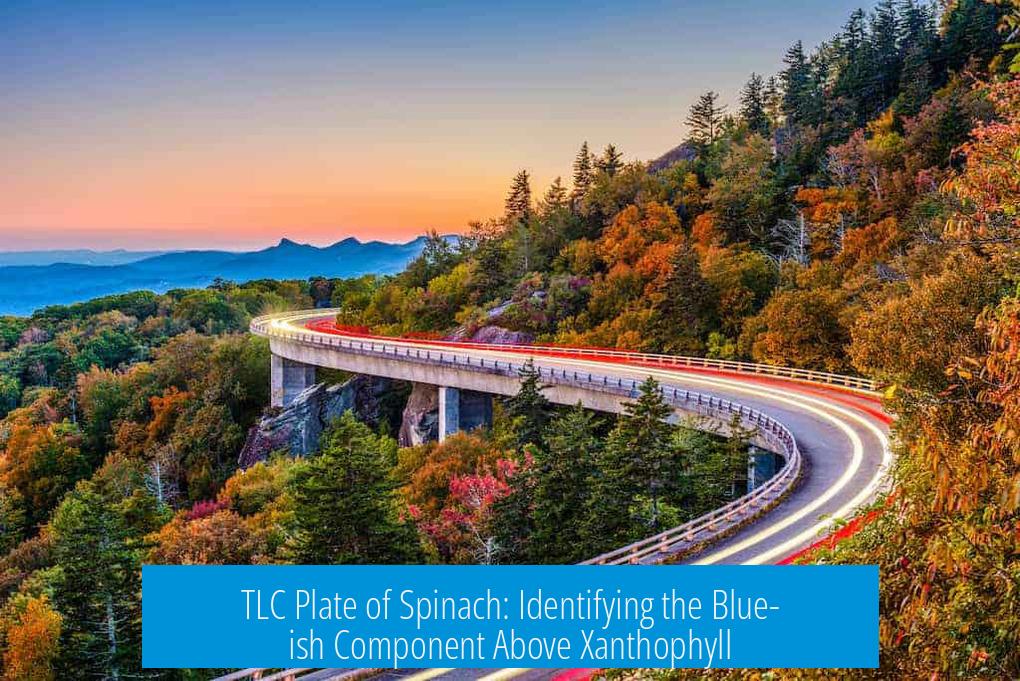
The blue-ish component on the right spot above the xanthophyll on a Thin Layer Chromatography (TLC) plate of spinach is likely a chlorophyll derivative or another intermediate polarity pigment. This conclusion stems from the behavior of pigments during chromatographic separation and their chemical properties.
Understanding Pigment Separation on TLC
TLC separates pigments based on polarity differences. The stationary phase is silica (SiO2), which is very polar. The mobile phase (a solvent or solvent mixture) moves upward by capillary action, carrying pigments along. More non-polar pigments travel further, while polar pigments remain closer to the origin.
- Xanthophyll: A yellow carotenoid pigment, relatively polar, thus it remains nearer to the baseline.
- Blue-ish Component Position: Located above xanthophyll but not as far as non-polar pigments like chlorophyll a.
Possible Identity of the Blue-ish Component
In spinach, pigment mixtures include chlorophylls and carotenoids, each with varying polarity:
| Pigment | Color | Polarity | Typical TLC Position |
|---|---|---|---|
| Xanthophyll | Yellow | Polar | Close to origin |
| Blue-ish pigment (likely chlorophyll b) | Blue-green to bluish | Intermediate polarity | Above xanthophyll, moderate distance |
| Chlorophyll a | Green | Non-polar | Furthest from origin |
The blue-ish spot probably corresponds to chlorophyll b. Chlorophyll b absorbs blue light and has a slightly greater polarity than chlorophyll a, which aligns well with the pigment’s moderate migration above xanthophyll and below chlorophyll a.
TLC Plate Preparation and Pigment Visualization
The technique involves spotting spinach extract lightly on the silica TLC plate. The plate is placed in a solvent chamber; pigments separate based on affinity to silica and solubility in the mobile phase. After development, distinct colored spots appear vertically.
The pigment’s characteristic absorption of light and interaction with the stationary phase create the observed blue-ish color at the specific spot.
Summary of Key Points

- The blue-ish component above xanthophyll on a spinach TLC plate likely represents chlorophyll b or a related pigment.
- Pigments separate by polarity: polar xanthophyll stays near origin; intermediate polarity chlorophyll b moves farther; non-polar chlorophyll a travels the most.
- Silica stationary phase strongly affects migration due to its polarity.
- Blue-ish coloration relates directly to the pigment’s absorption spectrum and chemical structure.
Unveiling the Blue-ish Component on Spinach TLC Plates: What’s That Mysterious Spot Above Xanthophyll?
Chances are, if you’re peering at a thin-layer chromatography (TLC) plate of spinach pigments, you’ll notice a puzzle: a blue-ish spot sitting to the right, just above the yellow xanthophyll pigment. What could that be? Is it a pigment, an artifact, or a scientific illusion? Let’s decode this colorful mystery step-by-step.
The blue-ish component on a spinach TLC plate, positioned just above the xanthophyll spot, is typically a pigment with intermediate polarity, likely a chlorophyll derivative or a minor chlorophyll-associated compound that migrates farther than polar xanthophyll but less than non-polar carotenoids.
Now that we’ve tackled the main question, let’s zoom in and unpack this. Spoiler alert: understanding this blue-ish spot isn’t just a pigment identification quiz; it reveals fascinating chemistry behind plant pigments and how TLC works its magic.
Handling Your TLC Plate: Not Your Average Art Project
Before RGB colors pop into view, TLC plates demand a bit of TLC themselves. Literally. These plates consist of silica dioxide (SiO2) coated on a plastic backing. Silica is polar, so pigments interact based on their polarity.
Handle the plate with care—only by edges. No bending or smudging! If you mess up the plate, the colors won’t develop properly, much like a bad selfie.
Mark the origin lightly with a pencil (never ink!) and spot the spinach extract carefully using a capillary tube. The concentration of the spot matters here—too dilute and pigments will be faint; too concentrated and the spots will blur. Balance is key.
The Science Behind the Colorful Race
Once the spinach extract is spotted, the plate enters the solvent chamber. Think of the solvent as the getaway car that carries pigments uphill by capillary action. This solvent phase is called the Mobile Phase, while silica stays put as the polar Stationary Phase.
Pigments separate because of differences in their attraction to the mobile and stationary phases. Polar pigments stick more to the silica and travel less. Non-polar pigments hitch a freer ride and run further up the plate.
Spot the Players: Spinach Pigments on TLC
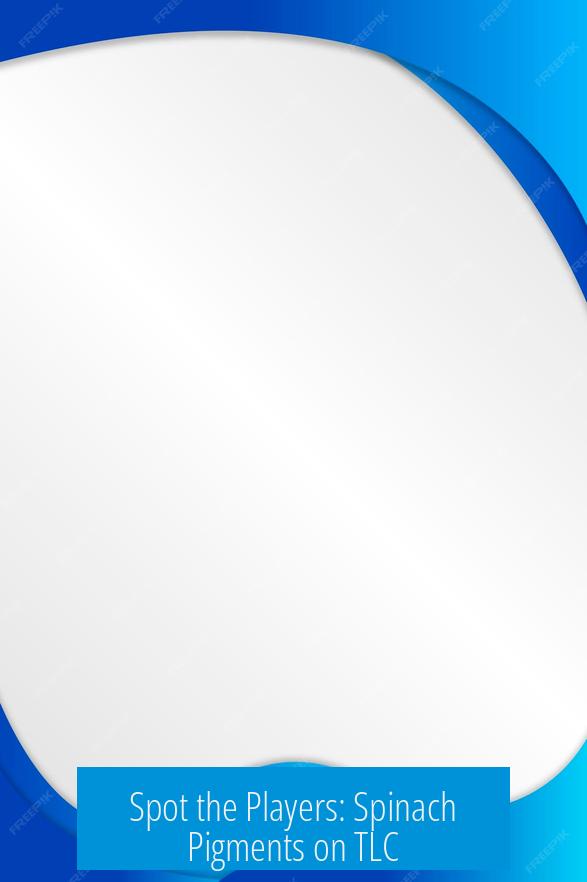
- Xanthophylls: Yellow carotenoids, polar to medium polarity. Usually found lower on the plate since they bind stronger to the silica.
- Chlorophylls: Green pigments. Chlorophyll a and b have different polarities and sometimes break down into derivatives, appearing as spots with blue-green or bluish hues.
- Carotenoids: Orange or red pigments, non-polar, moving highest.
Here’s the twist: the mysterious blue-ish spot you see right above xanthophyll isn’t typically named in basic guides. Unlike classic green chlorophyll or yellow xanthophylls, this blue shade suggests a specialized chlorophyll derivative or a minor pigment with intermediate polarity.
So, What’s the Blue-ish Component?
Most likely, this spot corresponds to chlorophyll b or its degradation products. Chlorophyll b is structurally similar to chlorophyll a but has slightly different polarity, causing it to migrate differently on the TLC plate.
This pigment’s blue-green coloration reflects its specific light absorption properties. The position—right above xanthophyll—agrees with its intermediate polarity: less polar than xanthophyll, but more than non-polar carotenoids. Hence, it doesn’t run too far or stay near origin. A classic middle-of-the-road pigment.
Sometimes, degraded chlorophyll products like pheophytins or pheophorbides can also have bluish hues and appear near this area. Spinach extracts, particularly if not fresh or exposed to acidic solvents during extraction, may contain these derivatives.
Why Does This Matter?
- Understanding Plant Photosynthesis: Chlorophyll b plays a supporting role in photosynthesis, capturing light energy especially in shaded conditions. Spotting it on TLC helps us appreciate plant pigment complexity.
- Scientific Research and Quality Control: Analyzing pigments on TLC plates is standard in plant biochemistry labs. Spotting the right pigments validates extraction protocols or plant stress responses.
- Educational Benefits: For students and enthusiasts, identifying blue-ish spots encourages critical thinking about pigment polarity and chromatographic principles.
A Personal TLC Tale
Once in a lab, a colleague and I got stuck on the bluish spot’s identity. Armed with pigment charts and patience, we confirmed it as chlorophyll b. It was a small win but made us appreciate how our eyes might miss important details without chromatography. The blue-ish spot told a story of pigment diversity and polarity dance.
Tips for Clearer Pigment Separation on Your TLC Plate
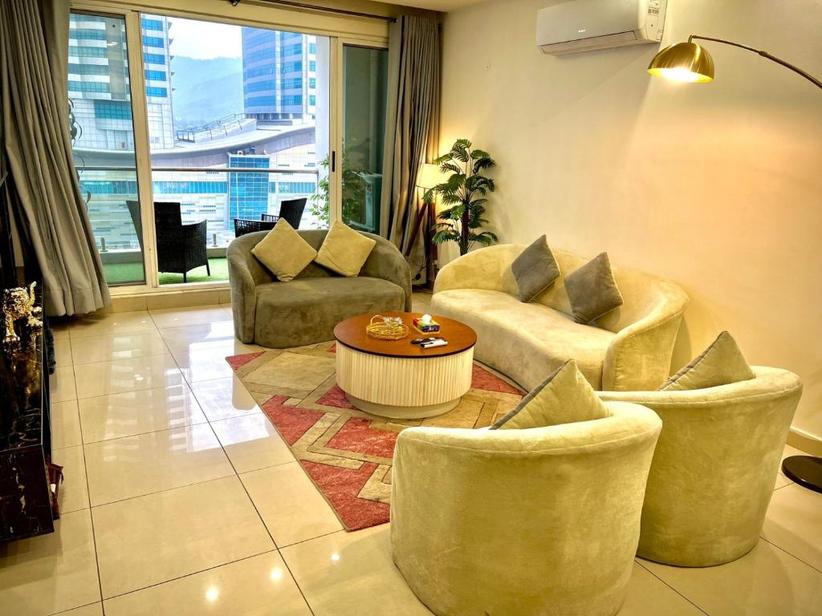
- Use fresh spinach leaves to avoid excessive pigment degradation.
- Be mindful of spot concentration—multiple light layers beat one thick blob.
- Choose solvents carefully—hexane:acetone mixtures often offer balanced polarity for pigment separation.
- Mark solvent fronts promptly to measure pigment migration accurately.
Frequently Asked Questions
Q: Could the blue-ish spot be a contamination or artifact?Unlikely if procedure is careful. Consistent appearance across repeats suggests a genuine pigment.
Q: Why isn’t the blue pigment chlorophyll a (more green)?Chlorophyll a usually runs differently and appears greener. The blue hue corresponds more closely with chlorophyll b or derivatives.
Q: Can blue pigments in spinach TLC result from phycobiliproteins?Spinach doesn’t contain phycobiliproteins. They are common in red algae and cyanobacteria, not typical leafy greens.
Wrapping It Up: The Colorful Truth
The blue-ish pigment appearing just above xanthophyll on a spinach TLC plate is a fascinating, intermediate polarity pigment—likely chlorophyll b or a related derivative. It serves as a reminder that even common leaves hold a symphony of pigments, each with unique chemical personalities.
Next time you set up a TLC plate with spinach, enjoy the chemical show. Observe those colors not just as spots, but as clues to plant life’s complex chemistry. That little blue spot? It’s a star performer in nature’s photosynthetic orchestra.
What does the blue-ish spot above xanthophyll on a spinach TLC plate represent?
This spot likely corresponds to a pigment with intermediate polarity. It is not explicitly identified but could be a chlorophyll derivative or another pigment migrating just above xanthophyll in polarity.
Why does the blue-ish component appear to the right and above xanthophyll on the TLC plate?
The pigments separate by polarity; less polar pigments move farther up and right. The blue-ish component’s position suggests it has a polarity between xanthophyll and other pigments. TLC separates pigments based on their affinity for silica.
Could the blue-ish spot be chlorophyll or a known pigment in spinach?
It may be a chlorophyll-related compound. Chlorophylls normally appear green, but derivatives can show blue-ish hues. Exact identity isn’t confirmed in the content but this is a possible explanation.
How does the stationary phase affect the migration of the blue-ish pigment?
The stationary phase is polar silica gel that holds back polar pigments. Intermediate polarity compounds like the blue-ish pigment travel further but less than non-polar pigments, landing above xanthophyll on the plate.
Can the blue-ish pigment on the TLC plate change color during the experiment?
Yes, pigments can undergo minor chemical changes during spotting or exposure to light, sometimes altering their observed color slightly. This might explain the blue-ish hue seen on the TLC plate.


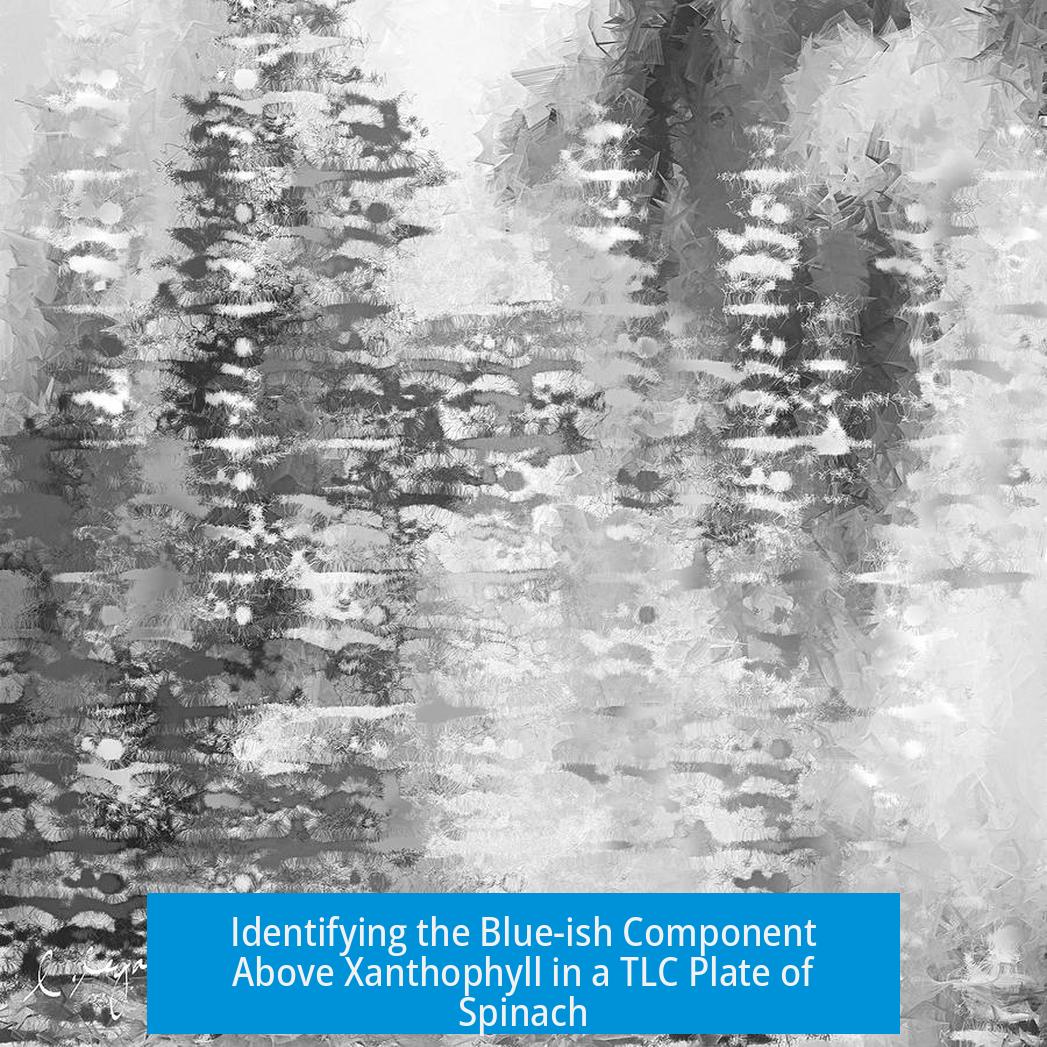

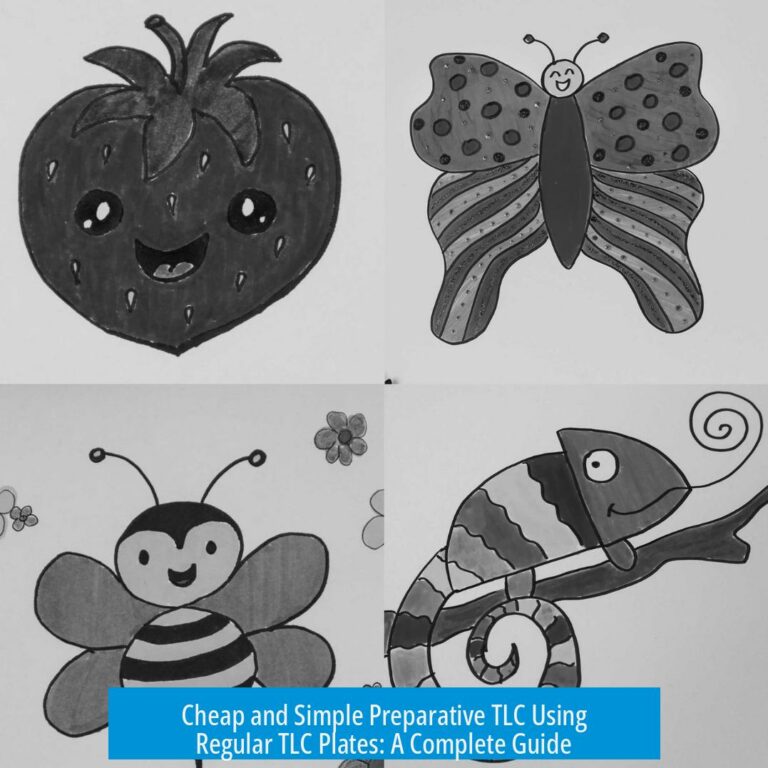
Leave a Comment